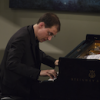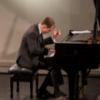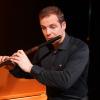About three years ago, pianist Gilles Vonsattel called a family meeting. He had been presented with an exciting career opportunity, but it would impact his wife and children — he wanted to make sure he had their support.
His question for them: Would they mind if he spent more time than usual at the keyboard, learning all 32 of Beethoven’s piano sonatas?
The critically acclaimed pianist had already performed quite a few, but given the set’s size and complexity — 11 hours of music, much of it quite difficult — he would have a whole lot of practicing to do.
Their response: Go for it.
“They have to put up with hours and hours of [listening to me practice] this stuff,” he said. “But I think they like the switch from my more esoteric repertoire to all-Beethoven, all the time.
"My neighbors certainly appreciate the change,” he added with a chuckle.
All of that effort will pay off Oct. 28 through Nov. 2, when Vonsattel will begin a three-season traversal of the cycle for the Southern California chamber music ensemble, Camerata Pacifica. In addition, he will perform all 32 sonatas at the Bay Area’s Music@Menlo series beginning next summer.
Somewhat audaciously, he is opening the SoCal cycle, which includes concerts in Los Angeles, Santa Barbara, San Marino, and Thousand Oaks, with the “Hammerklavier” Sonata — the longest and most challenging of the works. “I think of it as Mount Everest,” he said. “It really sticks out.”
Vonsattel, 44, discussed the joys and challenges of playing Beethoven, and the personal journey that led him to this point, in an interview from his Manhattan home. Our conversation has been edited for clarity and concision.
Why plunge into the Beethoven cycle, and why now?
The genesis was being asked by [Music@Menlo artistic directors] David Finckel and Wu Han to do it. I played Op. 111 at Menlo in a recital a couple of years ago. I think that’s what prompted them to make that request. They’ve also heard me play a lot of Beethoven with the Chamber Society of Lincoln Center, where I’ve been playing since I was in the young artists’ residency program in 2008.
What was your initial reaction to being asked?
I had to think about it. It’s a huge commitment, and a big change of direction in terms of my personal repertoire — what I choose to work on. I’ve always played a healthy dose of Beethoven, but my own programming has been much more focused on lesser-known works, substantial contemporary repertoire, and exploring interesting links between pieces. When I play a recital, I like it to be something that no one else has done. A Beethoven cycle is not that. So this is a departure in that sense.
From a logistical point of view, it requires a lot of stamina. Hans von Bulow, who created the tradition of playing the cycle, said there are no easy pieces. There really aren’t! You can’t take anything for granted. They are so demanding. But it’s extraordinarily rewarding.
They certainly never grow old, no matter how many times you have heard them.
A lot of that is attributable to design philosophy, or aesthetic choice that [Austrian composer and teacher Carl] Czerny noted: Every piece is based on a small idea, and Beethoven remains true to that small idea down to every embellishment and detail.
There’s plenty of virtuosity — it’s really challenging music — but it’s secondary to that. It’s a great approach to creation — a way to build something cohesive. Beethoven is able to put enormous emotional weight onto a scaffolding that anybody can understand and latch onto.
Over the decades, these pieces have been performed and recorded by many great pianists. How do you deal with the weight of that history?
The “Hammerklavier” has a famous metronome marking that it is very fast. Czerny writes, ‘With proper practice, this can be achieved.’ Von Bulow writes, ‘Czerny has no idea what he’s talking about.’ So, two of the first people to tackle these don’t agree [on how to approach them]. When you find that sort of thing in your research, it’s liberating. You have lots of options!
I’ve also been listening to the recordings by Artur Schnabel, the first person to record the cycle, and Fredrich Gulda. The way those two play the same movement can be so different! I’m a little bit leery about listening to ‘authoritative’ performances — those with an aura of ‘This is how this has to go.’ I find that less helpful at this point.
These pieces are strongly influenced by the development of the piano itself. The Op. 106 “Hammerklavier” was inspired by a new piano that Beethoven obtained. Can you hear in the sonatas how the piano was changing? Does that inform how you play them?
There’s a search for a new sonority that is obvious throughout the cycle. The Op. 7 sonata stands out to me in this regard. It’s a great piece that people may not know. It’s unusually dense. There’s an idea there of symphonic power. So even in that early work, there’s a search for how to get the piano to do more.
I’ve had a chance to play some of this repertoire on fortepianos, and it’s extremely interesting to me to understand the palate of colors — the sustain, the pedal, the much clearer bass line. I try to preserve some of that clarity of voicing when I move to a modern piano.
We feel the force of Beethoven’s personality in these works to a greater extent than any other piano works before him — and it is a strong personality! Is that part of the reason these remain so popular? That both players and listeners feel a personal connection to the composer?
Definitely. I had a conversation with someone recently who claimed music that doesn’t have melody isn’t consumable for a general public. But many times in Beethoven, you are hard-pressed to identify the melody. So how do you explain his popularity? I think it’s the fact his personality translates into drama. Listening to his music, there is a drama being played out between voices, between textures. You don’t need a doctorate in music to sense that.
We should also mention how weird and eccentric he is. He has an odd, genuinely funny sense of humor. So it’s a combination of the quirkiness of the personality, the violent contrasts, and the unique rhythmic propulsion. The crazy energy he unleashes always feels contemporary.
The “Hammerklavier” hardly qualifies as beautiful music, yet it’s never less than compelling.
It demands a lot from everybody, including the audience. I think that’s intentional. His goal in writing that piece was to challenge and provoke and test both the performers’ and the audience’s power of concentration and focus. If you stick with it, you’re left with something very meaningful.
One thing that’s interesting about Beethoven is there are lots of times when you hear the music of the future. In the ‘Hammerklavier,’ there is stuff that sounds like Chopin, Wagner, or Brahms. I’ll conclude the Camerata performances by playing a Chopin nocturne, the texture of which is exactly the same as a moment in the ‘Hammerklavier.’
Are you making a statement by starting the cycle with this mammoth work?
That was [Camerata Pacifica Artistic Director] Adrian Spence’s idea. But I really like it. I don’t know of any other cycle that has begun with this one. It’s subversive in a way Camerata’s programming tends to be. It’s like throwing your audience into a movie with the climactic scene. Which some movies do!
Let’s talk about your own narrative. You were born in Lucerne, Switzerland, but moved to the U.S. with your family at age 2, when your physician father got a job in Massachusetts. You are a dual citizen. When did you take up the piano?
I was 4 when I started playing. My parents both were amateur players. I also had a grandfather who was a popular accordion player in Switzerland. He was on the radio. So there was that in the family.
I always loved playing, but I never practiced more than two hours a day as a teenager, because I had so many things going on. I always assumed a career would be difficult to impossible. But when I got to Juilliard [after earning my undergraduate degree in political science and economics at Columbia], I decided to give it my best shot.
Tell us about some formative moments in your early life.
I audited the Van Cliburn competition in 2001. I heard such incredible playing from a polish and technical point of view, but I was a little shocked at how many people played the same things. As an audience member, I experienced a sense of diminishing returns.
I had my own big competitions coming up. That experience convinced me I needed to choose different repertoire [to stand out from the crowd]. That summer, I won a prize in Cleveland. Then I won the Naumburg International Piano Competition about a year later. My teacher, Jerome Lowenthal, really encouraged his students to explore. He got irritated if you showed up with the same things as everybody else.
Robert Mann of the Juilliard Quartet, who was running the Naumberg competition, gave me two foundational pieces of advice: Play lots of modern music, and play more chamber music.
Getting back to the Beethoven sonatas, are there any you have particularly warm feelings for, perhaps because they’re not as well-known as they deserve to be?
I love Op. 7, an absolutely wonderful piece. The Pastoral, Op. 28, is so gorgeous. I have a soft spot for Op. 14 No. 2, probably because my son, who is 11, learned it before I did! We’re comparing notes.




